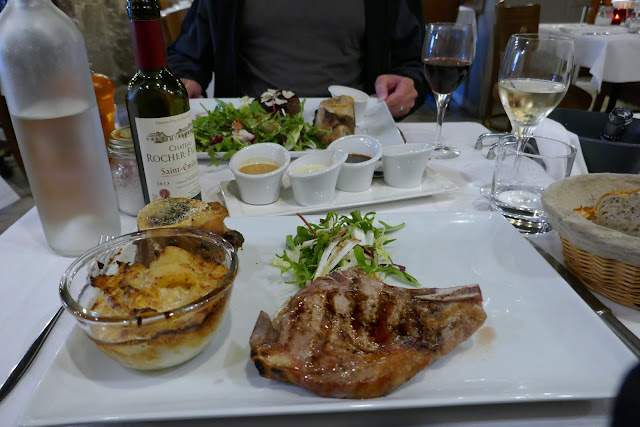 |
| Ibericos and Pinxtos -- 2 major decision factors |
[At an amazing meal in Dijon] E, taking another bite: Oh man, French food is heavenly.
Me, taking my own bite: Mmmm, I know. Although, in fairness, on our first night in France, you totally ordered a plate of various Spanish jamons and chorizos.
E, grinning: And it was good!
Me, taking a sip of wine: And French wine, so reasonably priced in France...
Both of us, sighing contentedly.
E: You know where the food and wine is not going to be this good? ...Poland. And all the other countries between there and Italy.
Me [laughing]: It's true. Remember the pickled sausage in Prague?
E: Also, it's been surprisingly cold in France. Have we checked the weather in central Europe?
Me: You know, there's no reason we *have* to go to central Europe. I want to visit all of those countries and sights on our list, but we don't have to do it this trip. It is a fairly ambitious itinerary, and it's been so nice to take it slow since we arrived. You make a good point about the weather. I know how much you love Spanish food (Jamon & Pulpo), and, obviously, Spain is much easier for both of us, linguistically, than any of the central European countries, so if you would rather just stay in western Europe, we could add Spain and figure out some other stops before showing up in Italy for the wedding...
And that was that.
After 20 days of eating gorgeous but filling composed plated meals in France (I pulled out all the adventure stops and had Andouillette for lunch as my last authentic meal - In case you were interested, that box has been checked by this *very* omnivorous eater and does not ever need to be revisited), the first dinner in Spain was such a great change.
Tapas that we could share. Olives with additional marination in the form of olive oil and some delicious spices on the outside. A salad of sliced tomatoes with onion, olive oil and oregano. A small plate of jamon. A bikini (toasted ham and cheese sandwich). Pa amb tomaquet (bread with tomato juice and olive oil on it). And that was it. We left feeling satiated, but thrilled with the light food and lack of heavy fat, cream, and sauce. Conveniently, in Catalonia, my mixing of French and Spanish as I transitioned back was welcomed as closer to Catalan.
 |
| Surtido de Embutidos |
 |
Pimientos de Padron -- when we get back to California,
I'm eating these every week until they are out of season.
|
 |
| End of the run in Girona. |
 |
| Best Pulpo of our trip. |
Zaragoza was a bit surprising, as neither of us had realized that Basque was prevalent there. At some point on the drive the signage switched from Catalan/Spanish to Basque/Spanish, which did not help with me trying to revert my brain to clean Spanish post-French, but did result in some more delicious food.
 |
| The coral where they hold the bulls before the running. |
We stopped for lunch in Pamplona and E's restaurant picking abilities were yet again on point. After an 11EU 2-course Basque set meal for both of us followed by cheese and espresso, we stopped to enjoy a drink in the bar on the square where Hemingway passed the time while writing The Sun Also Rises, and after watching the world go by, we found our way to the start of the circuit of the running of the bulls and walked the route to the stadium. This visit was particularly poignant for me, as Pamplona was one of the only places my Dad had ever gone in Europe (of course, for the running of the bulls -- he wore the traditional outfit with the red neck kerchief, although he didn't run and just stood high on a pillar and watched them go by).
 |
| View from Café Iruña into the Square in Pamplona. |
Again, we were surprised to realize that the signage in Pamplona was Basque/Spanish. The festival of San Fermin and the running of the bulls is actually a Basque Festival. I had thought that the Basque-speaking region of Spain was much smaller than it actually is before this trip. The only place I expected to find it in Spain was in San Sebastian, where I had been the guest of a French-speaking Basque family during the Basque Festival for the city, when hundreds of Basque descendants who had spread throughout the world (like my friend who took me from Bordeaux) returned to the town of their origins to celebrate. This visit was much more sedate, although still quite international, as the tourists dominate San Sebastian, at least downtown and along the waterfront.
 |
| View of San Sebastian from the other side of the bay. |
 |
| Running route in Burgos |
 |
| Our favorite Spanish Meal! |
We ate so well and enjoyed the people we met and the ease of being in a place where we could use a language we spoke/read reasonably well that we agreed that Spain is now up there with France, Argentina, Japan, and Italy as one our favorite places where we will always want to return.
Goodbye Spain, 'til we meet again.

















